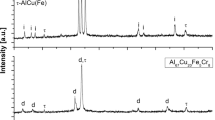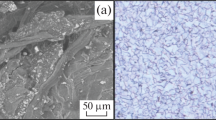Abstract
Quasicrystals have received some attention in recent years regarding their potential usefulness as low friction and wear resistant materials. When quasicrystalline (QC) coatings are exposed to different levels of external loading or are subjected to thermal stresses, crack nucleation, and propagation become life-limiting factors. In this investigation, Al59.2Cu25.5Fe12.3B3 QC coatings were deposited onto AISI-A36 steel substrates using the high-velocity oxygen-fuel (HVOF) technique. The coatings were deposited at different oxygen-to-fuel ratios. To characterize the integrity of the coatings, the active piezoceramic excitation technique was applied to detect the propagation of cracks during three-point bending tests. The piezoelectric transducer signal was processed using wavelet transformation analysis. The results revealed that the coated samples displayed different densities of cracks depending on the oxygen-to-fuel. The crack density was found higher for coatings formed using a slightly oxidizing flame. The opening of the pre-existing cracks in the coating was the main reason of signal attenuation during piezoelectric excitation. The HVOF-sprayed AlCuFeB quasicrystalline coating, with thickness between 150 and 180 μm, withstands a flexural stress as high as 340 MPa. To the best of our knowledge, this study is the first that provides a quantitative assessment of the viability of QC coatings in mechanical applications in spite of their intrinsic brittleness.











Similar content being viewed by others
References
Y. Fu, T. Peng, D. Yang, C. Sun, Y. Chen, and Y. Gao, HVOF Sprayed Al-Cu-Cr Quasicrystalline Coatings from Coarse Feedstock Powders, Surf. Coat. Technol., 2014, 252, p 29–34
B.A. Silva Guedes de Lima, R.M. Gomes, S.J. Guedes de Lima, D. Dragoe, M.-G. Barthes Labrousse, R. Kouitat-Njiwa, and J.-M. Dubois, Self-Lubricating, Low-Friction, Wear-Resistant Al Based Quasicrystalline Coatings, Sci. Technol. Adv. Mater., 2016, 17, p 71–79
U. Köster, W. Liu, H. Liebertz, and M. Michel, Mechanical Properties of Quasicrystalline and Crystalline Phases in Al-Cu-Fe Alloys, J. Non-Cryst. Solids, 1993, 153/154, p 446–452
Z. Xi-ying, L. Pei-yao, and Q. Shi-qiang, Evaluation of Fracture Toughness of Al-Cu-Fe-B Quasicrystal, J. Wuhan Univ. Technol., 2003, 8–4, p 46–49
S. Polishchuk, P. Boulet, A. Mézin, M.-C. de Weerd, S. Weber, J. Ledieu, J.-M. Dubois, and V. Fournée, Residual Stress in As-Deposited Al-Cu-Fe-B Quasicrystalline Thin Films, J. Mater. Res., 2012, 27–5, p 837–844
M. Shibata, S. Kuroda, H. Murakami, M. Ode, M. Watanabe, and Y. Sakamoto, Comparison of Microstructure and Oxidation Behavior of CoNiCrAlY Bond Coatings Prepared by Different Thermal Spray Processes, Mater. Trans., 2006, 47(7), p 1638–1642
J.M. Miguel, J.M. Guilemany, B.G. Mellor, and Y.M. Xu, Acoustic Emission Study on WC/Co Thermal Sprayed Coatings, Mater. Sci. Eng. A, 2003, 352, p 55–63
F. Aymerich and W.J. Staszewski, Impact Damage Detection in Composite Laminates Using Nonlinear Acoustics, Compos. A Appl. Sci., 2010, 41, p 1084–1092
Q. Feng, Q. Kong, J. Jiang, Y. Liang, and G. Song, Detection of Interfacial Debonding in a Rubber–Steel-Layered Structure Using Active Sensing Enabled by Embedded Piezoceramic Transducers, Sensors, 2017, 17, p 1–11
J. Zhu, Y. Zhang, and X. Liu, Simulation of Multi-cracks in Solids Using Nonlinear Elastic Wave Spectroscopy with a Time-Reversal Process, Wave Motion, 2014, 51, p 146–156
Z. Parsons and W.J. Staszewski, Nonlinear Acoustics with Low-Profile Piezoceramic Excitation for Crack Detection in Metallic Structures, Smart Mater. Struct., 2006, 15, p 1110–1118
N.H. Faisal and R. Ahmed, Acoustic Emission Analysis of Vickers Indentation Fracture of Cermet and Ceramic Coatings, Meas. Sci. Technol., 2011, 22, p 125704
S. Bouaricha, J.-G. Legoux, and P. Marcoux, Bending Behavior of HVOF Produced WC-17Co Coating: Investigated by Acoustic Emission, J. Therm. Spray Technol., 2004, 13–3, p 405–414
J.M. Dubois and E. Belin-Ferré, Friction and Solid-Solid Adhesion on Complex Metallic Alloys, Sci. Technol. Adv. Mater., 2014, 15, p 034804
J.M. Dubois, Properties and Applications of Quasicrystals and Complex Metallic Alloys, Chem. Soc. Rev., 2012, 41, p 6760–6777
J.M. Dubois, Useful Quasicrystals, World Scientific, Singapore, 2005
Y.J. Yan and L.H. Yam, Online Detection of Crack Damage in Composite Plates Using Embedded Piezoelectric Actuators/Sensors and Wavelet Analysis, Compos. Struct., 2002, 58, p 29–38
M. Fotouhi, H. Heidary, M. Ahmadi, and F. Pashmforoush, Characterization of Composite Materials Damage Under Quasi-Static Three-Point Bending Test Using Wavelet and Fuzzy C-Means Clustering, J. Compos. Mater., 2012, 46(15), p 1795–1808
F.R.P. Feitosa, R.M. Gomes, M.M.R. Silva, S.J.G. De Lima, and J.-M. Dubois, Effect of Oxygen/Fuel Ratio on the Microstructure and Properties of HVOF-Sprayed Al59Cu25.5Fe12.5B3 Quasicrystalline Coatings, Surf. Coat. Technol., 2018, 353, p 171–178
W. Rusch, Comparison of Operating Characteristics of Gas and Liquid Fuel HVOF Torches, in Proceedings of the International Thermal Spray Conference 2007 (ITSC 2007), Beijing, China, May 14-16 (ASM International, 2007), pp. 572–576.
K. Larsson, A. Silverbris, Crack Detection Using Non-linear Wave Modulation Spectroscopy. Master’s Degree Thesis, Department of Mechanical Engineering, Blekinge Institute of Technology, Karlskrona, Sweden (2003). ISRN: BTH-IMA-EX-2003/D-09-SE.
L. Zhao, M. Maurer, F. Fischer, R. Dicks, and E. Lugscheider, Influence of Spray Parameters on the Particle In-Flight Properties and the Properties of HVOF Coating of WC-CoCr, Wear, 2004, 257, p 41–46
J. Saaedi, T.W. Coyle, H. Arabi, S. Mirdamadi, and J. Mostaghimi, Effects of HVOF Process Parameters on the Properties of Ni-Cr Coatings, J. Therm. Spray Technol., 2010, 19–3, p 521–530
J. Stokes and L. Looney, Residual Stress in HVOF Thermally Sprayed Thick Deposits, Surf. Coat. Technol., 2004, 177–178, p 18–23
M. Gui, R. Eybel, B. Asselin, S. Radhakrishnan, and J. Cerps, Influence of Processing Parameters on Residual Stress of High Velocity Oxy-Fuel Thermally Sprayed WC-Co-Cr Coating, J. Mater. Eng. Perform., 2012, 21–10, p 2090–2098
U. Selvadurai, P. Hollingsworth, I. Baumann, B. Hussong, W. Tillmann, S. Rausch, and D. Biermann, Influence of the Handling Parameters on Residual Stresses of HVOF-Sprayed WC-12Co Coatings, Surf. Coat. Technol., 2015, 268, p 30–35
S. Nourouzi, M. Jalali Azizpour, and H.R. Salimijazi, Parametric Study of Residual Stresses in HVOF Thermally Sprayed WC–12Co Coatings, Mater. Manuf. Process., 2014, 29, p 1117–1125
A. Rabiei, D.R. Mumm, J.W. Hutchinson, R. Schweinfest, M. Rühle, and A.G. Evans, Microstructure, Deformation and Cracking Characteristics of Thermal Spray Ferrous Coatings, Mater. Sci. Eng. A, 1999, 269, p 152–165
E. Huttunen-Saarivirta, E. Turunen, and M. Kallio, Microstructural Characterization of Thermally Sprayed Quasicrystalline Al-Co-Fe-Cr Coatings, J. Alloys Compd., 2003, 354, p 269–280
Acknowledgments
This work was supported by the Conselho Nacional de Desenvolvimento Científico e Tecnológico - CNPq (Grant Number 401184/2014-5/PVE 2014). The authors wish to express their gratitude to Manager Flavio Morilla Camargo, manager of OPT-Brazil Company for the preparation of the HVOF samples and fruitful contribution to setting up the thermal spray parameters. Thanks are due to V. Fournée from Institut Jean Lamour, Nancy, France for the provision of QC powders.
Author information
Authors and Affiliations
Corresponding author
Additional information
Publisher's Note
Springer Nature remains neutral with regard to jurisdictional claims in published maps and institutional affiliations.
Appendix: Calculation of the Coating Flexural Stress
Appendix: Calculation of the Coating Flexural Stress
The tensile stress in the outer fiber of the coating is calculated based on classical composite beams theory. This model uses the transformed section method to consider the presence of two materials with different elastic modulus. In order to determine stress, both materials were represented as a single solid to calculate neutral axis location and moment of inertia. This transformation is made using the ratio of the elastic modulus:
In this case, quasicrystalline material is transformed into steel, as shown in Fig. 12, where: Eqc is the modulus of elasticity of the quasicrystalline coating and Es is the modulus of elasticity of steel. To find the neutral axis of the equivalent steel beam, the width of the steel is multiplied by n, Eq 2.
W2s and Wqc are the width of the transformed steel and of the coating (15 mm), respectively. The normal bending stress is given by the classical Eq 3.
However, the use of the new geometry resulting from transforming the width of the coating is needed. Thus, the centroid \(\bar{Y}\) and the transformed moment of inertia of the steel sections are given by Eq 4 and 5, respectively.
where tqc is the quasicrystalline coating thickness; ts is the steel substrate thickness and w2 is the transformed steel width given Eq 2. The geometric data used to calculate the stress are listed in Table 2.
Rights and permissions
About this article
Cite this article
Gomes, R., Feitosa, F.R., Souto, C. et al. Crack Detection in High-Velocity Oxygen-Fuel-Sprayed Al59.2Cu25.5Fe12.3B3 Quasicrystalline Coatings Using Piezoelectric Active Sensors. J. of Materi Eng and Perform 28, 5649–5660 (2019). https://doi.org/10.1007/s11665-019-04298-3
Received:
Revised:
Published:
Issue Date:
DOI: https://doi.org/10.1007/s11665-019-04298-3





